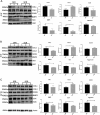Superior fulcrum reconstruction improve tendon-to-bone healing in irreparable massive rotator cuff tears compared with superior capsule reconstruction
- PMID: 40595372
- PMCID: PMC12215457
- DOI: 10.1038/s41598-025-09329-9
Superior fulcrum reconstruction improve tendon-to-bone healing in irreparable massive rotator cuff tears compared with superior capsule reconstruction
Abstract
Recently, superior capsule reconstruction (SCR) has achieved some results in the treatment of irreparable massive rotator cuff tears (IMRCT), but the incidence of various postoperative complications is high. The study aims to establish a model of IMRCT in rabbits, and compare the histomorphology and molecular biology differences between superior fulcrum reconstruction (SFR) and SCR, so as to provide a new and effective treatment method for the clinical treatment of IMRCT. Thirty-six mature New Zealand white rabbits were required for the experiment to build the model of IMRCT. The supraspinatus and subscapular muscle of the thirty-six rabbits were cut off and randomly divided into two groups of eighteen rabbits in each group, with SFR and SCR. Six rabbits in each group were sacrificed at 4, 8, and 12 weeks after surgery for histological and molecular assessment. Macroscopically, no retear occurred in SFR group and SCR group after surgery. The results of molecular biological showed that the expression levels of COL1, BMP2, SCX and SOX9 in the SFR group were significantly higher than those in the SCR group at 4 and 8 weeks (P < 0.05), while the expression of COL3 was lower than that in the SCR group. There was no significant difference in the expression of Aggrecan between the two groups at 4 weeks (P > 0.05). At 12 weeks after surgery, the expression levels of COL1, BMP2 and Aggrecan in the SFR group were significantly higher than those in the SCR group (P < 0.05), while COL3, SCX and SOX9 were not significantly difference between the two groups (P > 0.05). Histologically, collagen fiber maturity and fibrocartilage regeneration in the SFR group were superior to those in the SCR group at 8 and 12 weeks (P < 0.05). However, at 4 weeks, there was no significant difference between the two groups (P > 0.05). In an IMRCT rabbit model, healing processes of SFR and SCR are different, but both repair techniques were effective. SFR outperformed SCR in collagen fiber maturity, fibrocartilage regeneration, and tendon regeneration.
Keywords: Histological; Irreparable massive rotator cuff tears; Molecularly; Rabbit model; Superior capsule reconstruction; Superior fulcrum reconstruction.
© 2025. The Author(s).
Conflict of interest statement
Declarations. Competing interests: The authors declare no competing interests. Ethical approval: All the methods and experiments of this study were carried out in accordance with the relevant guidelines and regulations of Anhui Medical University. Moreover, the present animal study was performed in accordance with the guidelines and approval of the Institutional Animal Care and Use Committees (IACUCs) of Anhui Medical University. This study was conducted in accordance with the ethical standards set forth in the Declaration of Helsinki and its later amendments or comparable ethical standards. Moreover, our study is reported in accordance with ARRIVE guidelines. All procedures involving animal participants were approved by the Ethics Committee of The First People’s Hospital of Hefei (LLSC-YY2019-54).
Figures








Similar articles
-
Leptin Enhances M1 Macrophage Polarization and Impairs Tendon-Bone Healing in Rotator Cuff Repair: A Rat Model.Clin Orthop Relat Res. 2025 May 1;483(5):939-951. doi: 10.1097/CORR.0000000000003428. Epub 2025 Feb 19. Clin Orthop Relat Res. 2025. PMID: 39982019
-
Tissue-engineered Bicipital Autologous Tendon Patch Enhances Massive Rotator Cuff Defect Repair in a Rabbit Infraspinatus Tendon Defect Model.Clin Orthop Relat Res. 2024 Dec 1;482(12):2239-2255. doi: 10.1097/CORR.0000000000003218. Epub 2024 Sep 17. Clin Orthop Relat Res. 2024. PMID: 39467146
-
[Mid-term clinical outcomes of supraspinatus tendon reconstruction versus superior capsular reconstruction for the treatment of irreparable posterosuperior massive rotator cuff tears].Zhonghua Yi Xue Za Zhi. 2025 Jun 17;105(23):1918-1924. doi: 10.3760/cma.j.cn112137-20241213-02823. Zhonghua Yi Xue Za Zhi. 2025. PMID: 40495589 Chinese.
-
Outcomes of single-row and double-row arthroscopic rotator cuff repair: a systematic review.J Bone Joint Surg Am. 2010 Mar;92(3):732-42. doi: 10.2106/JBJS.I.01295. J Bone Joint Surg Am. 2010. PMID: 20194334
-
Better functional outcomes and a lower infection rate can be expected after superior capsular reconstruction in comparison with latissimus dorsi tendon transfer for massive, irreparable posterosuperior rotator cuff tears: a systematic review.J Shoulder Elbow Surg. 2023 Apr;32(4):892-906. doi: 10.1016/j.jse.2022.11.004. Epub 2022 Dec 14. J Shoulder Elbow Surg. 2023. PMID: 36528222
References
-
- Peng, Y. et al. Effect of mechanical stimulation combined with platelet-rich plasma on healing of the rotator cuff in a murine model. Am. J. Sports.50(5), 1358–1368 (2022). - PubMed
-
- Morse, K. et al. Arthroscopic versus mini-open rotator cuff repair: A comprehensive review and meta-analysis. Am. J. Sports Med.36(9), 1824–1828 (2008). - PubMed
-
- Lee, S., Park, I., Kim, M. S. & Shin, S. J. Clinical differences between patients with early and late revision surgery for symptomatic failed arthroscopic rotator cuff repair. Knee Surg. Sports Traumatol. Arthrosc.29(12), 3921–3928 (2021). - PubMed
-
- Kim, C., Lee, Y. J., Kim, S. J., Yoon, T. H. & Chun, Y. M. Bone marrow stimulation in arthroscopic repair for large to massive rotator cuff tears with incomplete footprint coverage. Am. J. Sports Med.48(13), 3322–3327 (2020). - PubMed
Publication types
MeSH terms
Grants and funding
LinkOut - more resources
Full Text Sources
Medical
Research Materials

